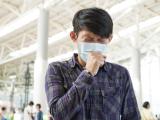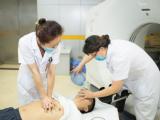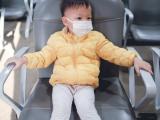Sep 9, 2004 (CIDRAP News) – By sifting data from hundreds of SARS (severe acute respiratory syndrome) cases in Hong Kong, researchers there have developed a scoring system for predicting whether a patient with suspicious signs and symptoms has the disease.
If the model is validated in studies of other SARS outbreaks, it could help emergency department physicians make decisions about hospital admission, isolation, and treatment for suspected case-patients if SARS returns, according to the report in the Sep 7 issue of Annals of Internal Medicine.
"Our findings suggest that a simple model that uses clinical data at the time of presentation to an emergency department during an acute outbreak predicted the incidence of SARS and provided good diagnostic utility," says the report by Gabriel M. Leung, MD, MPH, and colleagues.
To determine which signs, symptoms, and laboratory findings were the best predictors of SARS, the authors analyzed records on all patients who were evaluated in the SARS triage clinics at two large Hong Kong hospitals during 2 months in early 2003.
One cohort consisted of 1,274 patients who were seen at United Christian Hospital; this group included 821 residents of the Amoy Gardens housing complex, where a major SARS outbreak occurred. The other cohort included 1,375 patients who were examined at Prince of Wales Hospital. The incidence of SARS was 29.6% (377 of 1,274) in the United Christian cohort and 13.4% (184 of 1,375) in the Prince of Wales group.
The authors developed their scoring system in two steps designed to parallel physicians' decision-making processes. In the first step they looked at demographic data such as age, sex, occupation (healthcare worker or not), contact with SARS patients, travel history, symptoms, and vital signs. By statistical analysis, the investigators determined that age, contact history, fever, myalgia, and malaise were significant risk factors for a final diagnosis of SARS.
The researchers identified patients at high risk for SARS on the basis of step 1. In step 2, they analyzed the radiological and lab findings for these patients and looked further at the risk factors identified in step 1. The analysis showed that significant risk factors included haziness or pneumonia on chest radiograph and low lymphocyte and platelet counts. The further analysis also ruled out myalgia and malaise as significant risk factors. Factors that were significantly linked with a low probability of SARS included a high neutrophil count, sputum production, and young or old age (under 18 or 65 and up).
The authors further developed a point score for each risk factor, making it possible to calculate the overall risk by adding up the points. Patients above the threshold for high risk were further grouped into quartiles on the basis of their scores.
The scoring system worked well when the researchers tested it on the patient cohorts it was derived from, according to the article. The actual incidence of SARS in patients assigned to the low-risk group was 4.4%. In the high-risk group, the incidence of SARS was 21% in the first quartile, 39.5% in the second quartile, 61.2% in the third quartile, and 79.7% in the fourth quartile. The system achieved an "optimism-corrected sensitivity of 90%" and a specificity of 62%.
The researchers suggest that during a SARS outbreak, patients found to have a low risk on the basis of step 1—which requires only a history and physical exam—could be sent home and monitored daily until resolution of their symptoms. Patients found to be at high risk on the basis of step 2 should be admitted to an isolation ward for further assessment and possible treatment, the report says.
The authors list several limitations of their method, including the fact that it has not been tested against data from SARS outbreaks elsewhere. "Ultimately, the generalizability of the findings should be confirmed by using similar databases in other SARS-affected countries and should be prospectively validated if SARS returns," they write. They also note that the system is based on data from an acute outbreak and thus may not apply to isolated SARS cases during interepidemic periods.
In an accompanying editorial, three physicians from the Centers for Disease Control and Prevention say that additional testing of the prediction system is particularly important because it is based on combined data from two "epidemiologically distinct" groups of patients. The cohort from Prince of Wales Hospital included a much higher proportion of healthcare workers with past exposure to SARS patients than the other cohort did. In addition, the Amoy Gardens outbreak has been widely discussed because of its "peculiar epidemiologic characteristics," says the editorial by John A. Jernigan, MD, MS; Rita F. Helfand, MD, and Umesh D. Parashar, MBBS, MPH.
Leung GM, Rainer TH, Fei-Lung L, et al. A clinical prediction rule for diagnosing severe acute respiratory syndrome in the emergency department. Ann Intern Med 2004;141:333-42 [Full text]



















